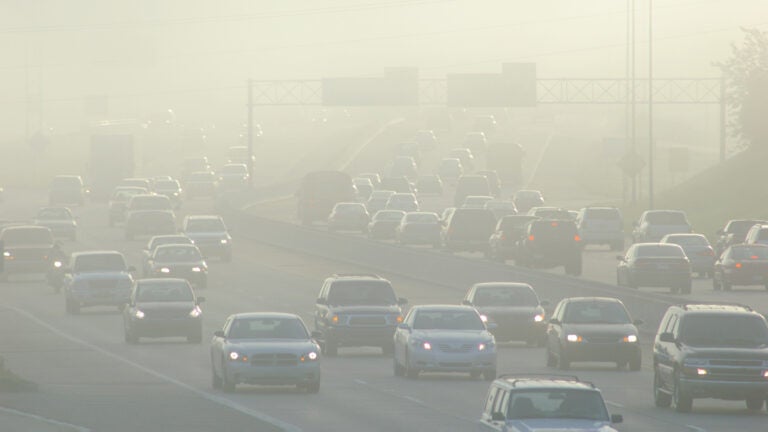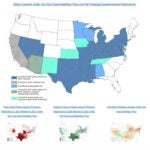
More than 100 million Americans live in communities where ozone levels exceed the current health standard. (Photo/iStock)
Supreme Court to consider ‘good neighbor’ rules that limit cross-state air pollution
EARTH MONTH: The nation’s highest court is considering putting a hold on a clean air rule that requires upwind states to reduce pollution affecting their downwind neighbors. USC environmental law expert Robin Craig weighs in.
The U.S. Supreme Court will soon decide how states must act as “good neighbors” when it comes to air pollution.

Three states — Ohio, West Virginia and Indiana — along with industry allies have petitioned the Supreme Court via its emergency appeals “shadow docket” to block a federal rule targeting ground-level ozone, or smog, that drifts across state lines.
The case, Ohio v. Environmental Protection Agency, centers on the EPA’s Good Neighbor Plan. Introduced in 2015 and finalized by the Biden administration in 2023, the plan is designed to prevent upwind states from causing air quality problems for their downwind neighbors. More than 100 million Americans live in communities where ozone levels exceed the current health standard.
The dispute coincides with broader efforts to recalibrate the balance of power between federal agencies and the courts, potentially shifting authority away from regulators like the EPA, the Food and Drug Administration and the Department of Agriculture, as well as hampering their ability to set and enforce health and environmental standards.

“The Supreme Court’s decision to hear arguments in this case may have been motivated by the fact that, given the nature of interstate ozone pollution, the good neighbor rule needs all affected states participating to effectively address interstate ozone,” said Robin Craig, an expert in environmental law at the USC Gould School of Law.
Good neighbor rules: Tougher air quality standards spark legal battle
Several states, including Wisconsin, New York and Connecticut, are struggling to meet current air quality standards, facing the dual challenge of managing their own emissions while also contending with pollutants that cross their borders from neighboring states.
In 2015, the EPA tightened its National Ambient Air Quality Standards (NAAQS) for ozone. While good for public health, the stricter standards pushed many states into noncompliance, including those like California that were already struggling with ozone issues and those on the cusp of meeting the previous standard, Craig explained.

“The EPA isn’t doing anything new legally. The difficulty is that the NAAQS became more stringent,” said Craig, who also holds the Robert C. Packard Trustee Chair in Law at USC Gould.
“Basically, the states at issue in Ohio v. EPA refused to even try, leaving the EPA to impose regulation on them,” she said. “So, people who live in downwind states (roughly the Northeast states) might not be able to enjoy the air quality that the EPA deems requisite to protect public health — the standard for setting the NAAQS — not because of their own failures, but because Southeastern and Midwestern states don’t want to crack down on their major emitters like coal-fired power plants.”
Craig noted that the West has tended to escape these legal dramas because, outside of California, air quality is often pretty good, the downwind states are largely unpopulated and the Rocky Mountains act as a barrier, preventing most air pollution from reaching the East Coast.
The nuts and bolts of the good neighbor rules case
The petitioners in Ohio v. EPA have requested the Supreme Court block the good neighbor rule’s implementation while their appeal progresses in the U.S. Court of Appeals for the District of Columbia Circuit. Right now, the court isn’t deciding if the good neighbor rule itself is valid. Instead, the judges are focusing on a more technical question: Should a lower court have allowed the EPA’s rule to take effect while legal challenges play out?
The EPA argues the rule is necessary to protect public health, while the opposing states and industries claim it’s an unachievable burden that will strain the electric grid.
A ruling in favor of the challengers could delay or weaken the good neighbor rule, potentially offering a lifeline to industries heavily reliant on major emitters like coal-fired power plants. On the other hand, a decision upholding the rule could force these industries to make significant and potentially expensive changes to comply with stricter emission controls, experts say.
“The court’s decision to review the case may signal that it is more willing than it has been in the past to step in to unify the country with regard to whether a rule is in force or not during a legal challenge,” said Craig, adding that it may also indicate a willingness to step in before states have to make some potentially very expensive alterations to how they do business.
Oral arguments were held in February. A decision is expected by June.



